If one feature has made modern cars easy to use, it’s the power steering. Composed mainly of a power steering rack and a hydraulic pump, this system allows us to manipulate heavy vehicles with one finger. That being said, the entire system can go bad over time, especially on high mileage old cars.
Because of that, we’ve prepared this short guide on how to fresh a power steering setup on an old E36 325i. Although this is a BMW specific guide, the main principles remain the same for most vehicles that run a hydraulic steering rack setup.
The Anatomy of a Power Steering System
The whole idea behind a power steering system is to have some sort of mechanical aid helping you turn the wheel. There are two main types of power steering – hydraulic and electric. The latter is the more modern solution, but there’s still plenty of cars running hydraulics.
Back in the day, hydraulic power steering was the norm. Your average setup consists of the steering gearbox, a hydraulic pump driven by the accessory belt, and the hose/reservoir network that circulates the system’s fluid.
Hydraulic power steering might be obsolete by today’s standards, but it has its perks. One of them being the connection with the road. Enjoying that direct, mechanical link with the road surface is something rarely any fly-by-wire system can mimic.
However, there are drawbacks as well. Especially when your power steering is over two decades old. Here’s a few things that might go wrong on any car that has this type of steering.
When Power Steering Takes a Wrong Turn
Like any other hydraulic system, there are known issues that might and often appear over time. The E36 325i we’re going to use later to demonstrate some fixes is notorious for its power steering issues.
Leaks, Leaks Everywhere
Every hydraulic steering system has a high-pressure line and a low-pressure return line. The high-pressure line drives the steering rack while the low-pressure line returns the hydraulic fluid back into the reservoir, thus completing the loop.
Wherever there’s high pressure, there is a risk of leaks. Hydraulic lines go bad over time due to material fatigue, environmental effects, and many other reasons. When they go bad, they’ll start to leak.
Power Steering Pump Failure
Leaks left unaddressed can bring the fluid levels down to a point where the pump is no longer being lubricated. Once that happens, the pump might fail. Truth be told, the pump itself could spring a leak if the seals and gaskets inside go bad.
Either way, it pays to keep track of how much fluid there is in the system. A leaking power steering system will work as long as you top it off with fluid.
How to Quickly Check the System for Leaks?
Checking the system for leaks is fairly simple. There are three places you’d want to inspect – the pump itself, the high-pressure line, and the steering rack ends. Checking these three parts of the system will show the first signs of trouble in 90% of the scenarios.
Sometimes the leak is subtle enough where you might not notice it right away. Look for fresh fluid around the main seals, gaskets, and hose clamps.
Refreshing the Power Steering System on a BMW E36 325i
The situation with E36 is slightly abnormal compared to other vehicles. Reason being that BMW made a few mistakes when designing the power steering system on these cars that often leads to various failure points appearing all over the place.
Because of that, it might be necessary to replace a bunch of stuff, all at the same time. That’s precisely what’s been done on this particular 325i we’re chosen as the guinea pig. Here’s the part list of everything that was changed:
- Power Steering Reservoir
- Power Steering Feed Hose
- Power Steering Pressure Hose
- Power Steering Return Hose
- Seal Rings for the High-Pressure Line (X4)
- Seal Rings for the Low-Pressure Lines (X4)
- Hose clamps (x2)
- Power Steering Fluid
And here are the tools that we’ve used to get the job done:
- 10mm,19mm, and 22mm Sockets
- 3/8″ Drive Socket Wrench
- 3/8″ Drive 3″ Extension Bar
- 3/8″ to 1/2″ Adapter
- 1/2″ Drive Socket Wrench
- 10mm, 19mm, and 22mm Box Wrenches
- Flathead Screw Driver
- Funnel
- Drain Pan
Step 1 – Lift the Car
The very first thing we need to do is lift the automobile, allowing us to get under it safely. Use proper jack stands or ramps to secure the vehicle in the air. Always use safeties where necessary. We also like to leave the floor jack under the automobile as a failsafe of sorts.
Step 2 – Disconnect the Air Filter and Cruise Control Module
Next, we need to disconnect the intake hose from the air filter box by removing the metal clips that hold it in place. Once done, remove the cruise control connectors by twisting them to the left. Two 10mm nuts hold the cruise control box and air filter box in place. Remove those as well.
Step 3 – Clear a Path to the Power Steering Reservoir
With the air filter box free, move it out of the way to reveal the power steering fluid reservoir. Next, drain the system. To do this, get underneath the vehicle and remove the reservoir’s feed line by undoing the 22mm banjo bolt as pictured above. Remove the hose from the reservoir and place a drain pan to collect the fluid.
Step 4 – Disconnect the High-Pressure Line
Next up, we need to remove the high-pressure line from the power steering pump. Just remember how the hose is oriented before you take it off. Once the pump side has been removed, follow the hose to the other end and remove the bolt holding it in place on that side as well.
Step 5 – Disconnect the Return Hose from the Rack
To remove the return hose from the rack, you’ll need to remove two 10mm bolts that connect it to the rack. There’s also a 22mm banjo bolt at the end of the hose, where it meets the rack. Remove all of that and then remove the line from the reservoir.
Step 6 – Remove the Reservoir
Next, remove the reservoir by making sure to take the mental note of its orientation. You’ll need to loosen the 10mm bolt on the mounting clamp to free the reservoir.
Reassembly
To reassemble the power steering system, follow these steps:
- Connect the high-pressure line to the rack but make sure to put crush washers on both sides before inserting the banjo bolt.
- Partially tighten the bolt with your hand.
- Bend the hose to the pump, apply the washer on each side along with the banjo bolt and start it by hand.
- Hand tighten both ends of the hose and make sure that the hose’s metal part is pointing down.
- Slide the low-pressure hose in place with the cooling line in front of the rack.
- Get two 10mm bolts started that hold it in place
- Attach the low-pressure line to the rack
- Slide to line onto the reservoir, apply hose clamps but don’t tighten it
- Position the hose in a way that allows you to get the feed line down on the power steering pump. Attach the banjo bolt.
- Slide the clamps on the return hose and connect it to the bottom of the reservoir
- Tighten the hose clamps until snug.
- Add fluid until the reservoir is close to full
- Turn the ignition to the ON position without starting the automobile and rotate the wheel left to right a few times
- If the fluid is still near the top in the reservoir, start the automobile and rotate the wheel lock to lock.
- Shut the automobile off and top off the fluid.
- Inspect the undercarriage for any leaks
- If all is good, reinstall the air filter box and cruise control module.
Where to Get Quality Power Steering Parts?
If you’re looking for quality power steering parts for your BMW or any other European car manufacturer, you’re in the right place! We offer one of the largest catalogs of European car parts. You’ll find Genuine, OEM, and aftermarket products in our offer.
To find parts for your specific vehicle, simply head over to our online store and input your car’s details. Our system will crunch the data and give you a list of products that match. If you have any questions regarding our offer, please get in touch with us via email. Our customer support reps are standing by to offer assistance.


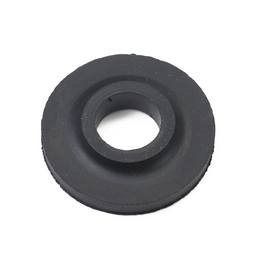

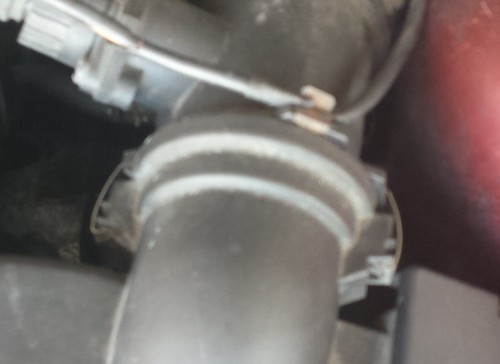

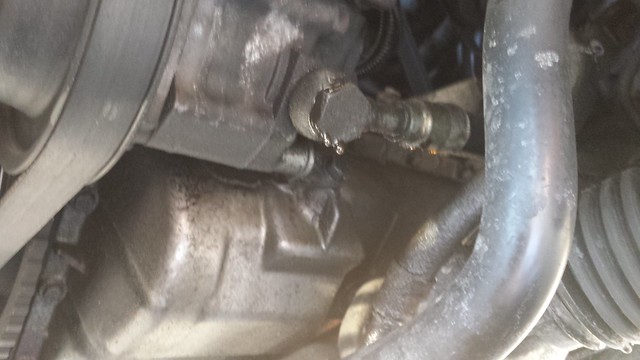
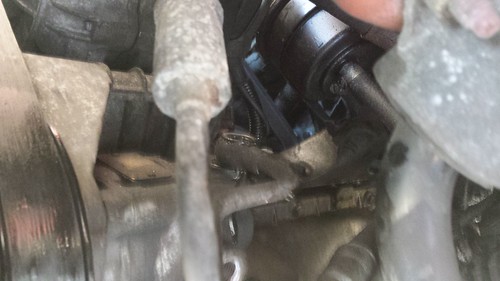
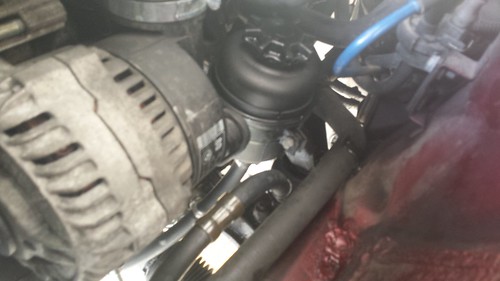


Thanks for the great tutorial (especially the pictures–super helpful!). My brother recently purchased an older car, and it just started doing the telltale power steering whine. We’ll be looking at it today to see if it’s something we should fix ourselves or take to a mechanic. Hopefully it’s a relatively simple fix either way!